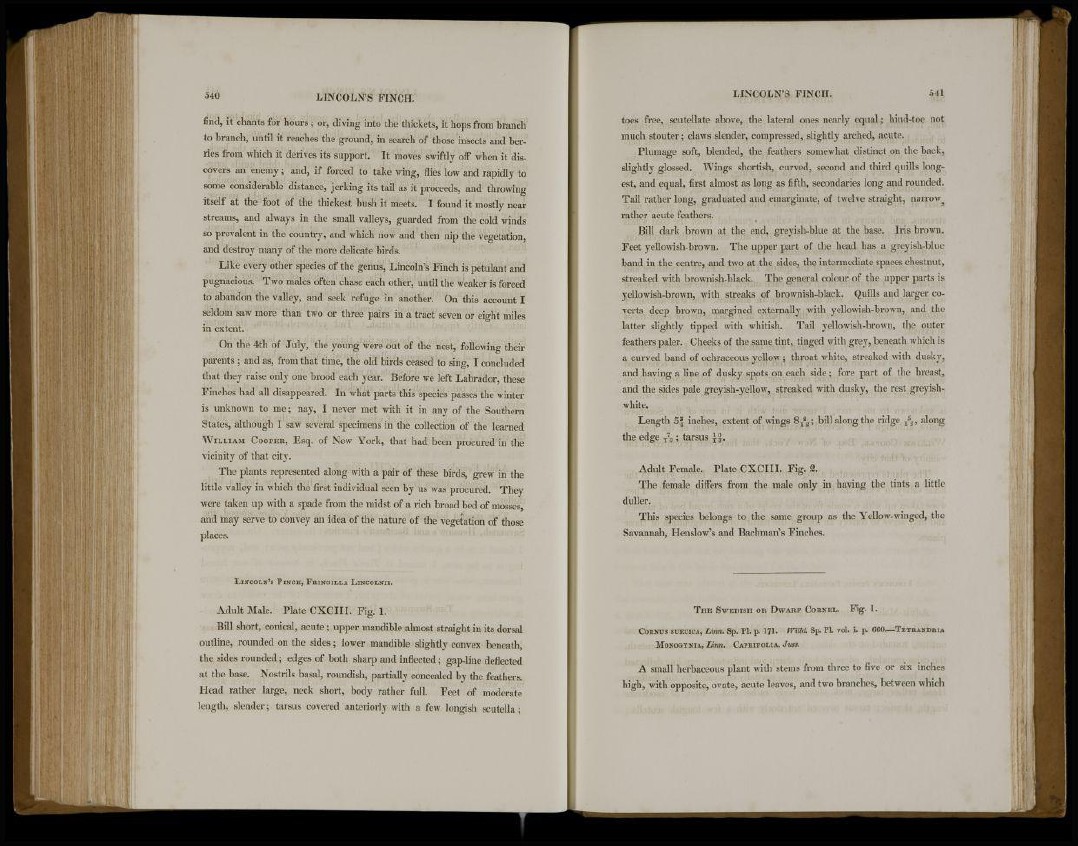
find, it chants for hours ; or, diving into the thickets, it hops from branch
to branch, until it reaches the ground, in search of those insects and berries
from which it derives its support. It moves swiftly off when it discovers
an enemy; and, if forced to take wing, flies low and rapidly to
some considerable distance, jerking its tail as it proceeds, and throwing
itself at the foot of the thickest bush it meets. I found it mostly near
streams, and always in the small valleys, guarded from the cold winds
so prevalent in the country, and which now and then nip the vegetation,
and destroy many of the more delicate birds.
Like every other species of the genus, Lincoln's Finch is petulant and
pugnacious. Two males often chase each other, until the weaker is forced
to abandon the valley, and seek refuge in another. On this account I
seldom saw more than two or three pairs in a tract seven or eight miles
in extent.
On the 4th of July, the young were out of the nest, following their
parents ; and as, from that time, the old birds ceased to sing, I concluded
that they raise only one brood each year. Before we left Labrador, these
Finches had all disappeared. In what parts this species passes the winter
is unknown to me; nay, I never met with it in any of the Southern
States, although I saw several specimens in the collection of the learned
WILLIAM COOPER, Esq. of New York, that had been procured in the
vicinity of that city.
The plants represented along with a pair of these birds, grew in the
little valley in which the first individual seen by us was procured. They
were taken up with a spade from the midst of a rich broad bed of mosses,
and may serve to convey an idea of the nature of the vegetation of those
places.
LINCOLN'S FINCH, FBINGILLA LINCOLNII.
Adult Male. Plate CXCIII. Fig. 1.
Bill short, conical, acute ; upper mandible almost straight in its dorsal
outline, rounded on the sides; lower mandible slightly convex beneath,
the sides rounded; edges of both sharp and inflected; gap-line deflected
at the base. Nostrils basal, roundish, partially concealed by the feathers.
Head rather large, neck short, body rather full. Feet of moderate
length, slender; tarsus covered anteriorly with a few longish scutella;
toes free, scutellate above, the lateral ones nearly equal; hind-toe not
much stouter; claws slender, compressed, slightly arched, acute.
Plumage soft, blended, the feathers somewhat distinct on the back,
slightly glossed. Wings shortish, curved, second and third quills longest,
and equal, first almost as long as fifth, secondaries long and rounded.
Tail rather long, graduated and emarginate, of twelve straight, narrow^
rather acute feathers.
Bill dark brown at the end, greyish-blue at the base. Iris brown.
Feet yellowish-brown. The upper part of the head has a greyish-blue
band in the centre, and two at the sides, the intermediate spaces chestnut,
streaked with brownish-black. The general colour of the upper parts is
yellowish-brown, with streaks of brownish-black. Quills and larger coverts
deep brown, margined externally with yellowish-brown, and the
latter slightly tipped with whitish. Tail yellowish-brown, the outer
feathers paler. Cheeks of the same tint, tinged with grey, beneath which is
a curved band of ochraceous yellow; throat white, streaked with dusky,
and having a line of dusky spots on each side; fore part of the breast,
and the sides pale greyish-yellow, streaked with dusky, the rest greyishwhite.
Length 5* inches, extent of wings 8 j a
g ; bill along the ridge A, along
the edge T
7
2 ; tarsus \ g.
Adult Female. Plate CXCIII. Fig. 2.
The female differs from the male only in having the tints a little
duller.
This species belongs to the same group as the Yellow-winged, the
Savannah, Henslow's and Bachman's Finches.
THE SWEDISH OR DWARF CORNEL. Fig. 1.
CORNUS SUECICA, Linn. Sp. PI. p. 171- Willd. Sp. P L vol. L p. GCO.—TETRANDRIA
MONOGYNIA, Linn. CAPBIFOLIA, JWS.
A small herbaceous plant with stems from three to five or six inches
high, with opposite, ovate, acute leaves, and two branches, between which